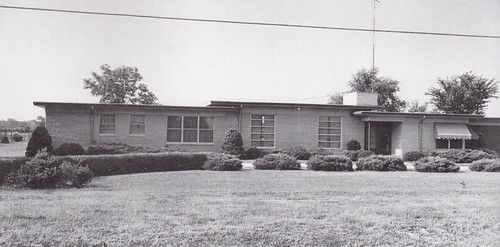On May 28, 1950, Joplin’s swanky Roanoke neighborhood was the scene of a vicious crime that remains unsolved to this day. The body of forty-nine-year-old Gwendolyn Creekmore was found brutally bludgeoned and burned in the home she shared with her mother, Hallie Creekmore, at 915 North Sergeant. She had been beaten repeatedly in the head with a meat hammer. Mercurochrome, a poison, was also found at the crime scene. An autopsy later revealed the poison was present in her stomach and kidneys, but it was unclear if she had willingly ingested it. It was, as one press account declared, “The strangest death case in the modern history of Jasper County.”
Gwendolyn Creekmore, dubbed “Joplin’s Poor Little Rich Girl,” by the Joplin press, was born Elizabeth Gwendolyn McCarthy. When her mother Hallie married businessman William J. Creekmore in 1901, he adopted the young girl, and she became Gwendolyn Creekmore. When she was an infant, she contracted an unknown illness that impaired her mobility and ability to speak. Despite her physical ailments, Gwendolyn grew up in relative comfort in a protective household.
Her adoptive father, William J. Creekmore, was a successful businessman. He owned cattle ranches in Missouri, Kansas, and Texas; successfully speculated on large amounts of real estate at Tulsa, Oklahoma; and purchased Joplin’s Milwaukee Beer Company, a large wholesale liquor distributor.
During Oklahoma’s oil boom, Creekmore capitalized on his wholesale liquor business in Joplin, selling spirits to thirsty wildcatters across the state line. He soon branched out and, according to one account, his “illicit distribution network expanded into nearly every county in Oklahoma.” Creekmore was dubbed the “King of the Oklahoma Bootleggers.” He funneled his wealth into real estate at Jay, Oklahoma, and in 1912, built a handsome residence in Joplin’s exclusive Roanoke neighborhood at 915 North Sergeant.
Success came at a price: Creekmore caught the unwanted attention of the federal government. He spent time in an Oklahoma jail, and, later, two years in Leavenworth Federal Penitentiary for jury tampering. Although he swore that he was “out of the liquor business,” Creekmore was suspected of financially backing the region’s illicit liquor industry throughout Prohibition. In 1934, he died from complications from diabetes. Creekmore left his estate, estimated to be worth roughly $5 million in today’s money, to his wife. He was buried in the family plot in Lamar, Missouri.
Creekmore’s widow, Hallie, and adopted daughter, Gwendolyn, continued to live in the family’s Joplin residence after his death. By some accounts, Creekmore was overly protective of his adopted child, and reportedly did not allow Gwendolyn to date while he was alive. Shortly after his death, however, she married C.B. Farnahan. Farnahan stole the family’s sedan and left town, never to be seen again. Gwendolyn received a divorce in 1936 and subsequently married area resident Cliff Polston. The marriage lasted a year before the couple divorced. She was reportedly engaged to yet another suitor, but the relationship ended before the two married. Creekmore then began seeing Joplin resident Lee Moxley.
After Creekmore’s body was discovered, Moxley was brought in for questioning. Police also questioned her former husband Cliff Polston and the Creekmore family’s former yardman. Moxley claimed to have an alibi; insisting he had went to a family reunion, and then returned home. He later willingly went with Joplin detectives to Jefferson City to take a polygraph exam. Hallie Creekmore, who had been in ill health, insisted from her hospital bed at St. John’s Hospital that Moxley was supposed to bring her daughter by to see her at the hospital that evening. Moxley denied her statement.
Coroner Dr. W.W. Hurst stated that Gwendolyn Creekmore had been brutally murdered; that it was impossible she could have committed suicide. Police admitted that they were perplexed by the murder. They could not explain why a cocked .38 revolver belonging to the Creekmore family was found next to the telephone in the living room, why there was an old lamp cord in the middle of Creekmore’s bed, or why the basement door, generally kept locked, was found unlocked. Detectives were also puzzled that her expensive diamond jewelry was left undisturbed in the home. Despite a second polygraph, Lee Moxley continued to protest his innocence. A cab driver told the coroner’s jury that after he had picked Creekmore up from the hospital after she had finished visiting her mother, she had asked to stop by a pharmacy to buy poison. He refused and drove her home.
On June 5, as Joplin police officials continued to investigate Gwendolyn Creekmore’s murder, Mayor H. Chris Oltman ordered a departmental shake-up. Both Chief of Police Roy Isgrigg and the Detective Chief Luther Laster were demoted. Isgrigg, Laster, and special representative Everett Patrick were ordered to investigate Creekmore’s murder full-time. Mayor Oltman declared, “The Creekmore case is not going to be dropped.” He voiced his disgust that the police had failed to secure the crime scene, failed to take fingerprints, and had failed to prevent trespassers from entering the Creekmore residence. A month later, the police investigation failed to uncover any further leads, with authorities trying to decide whether or not it was a murder or a bizarre suicide. The case remains unsolved.









